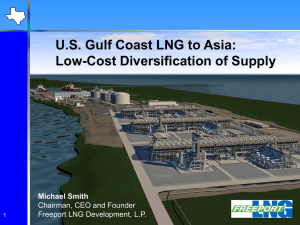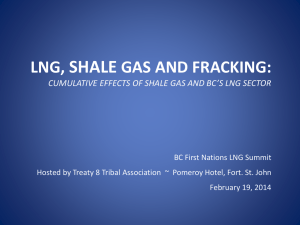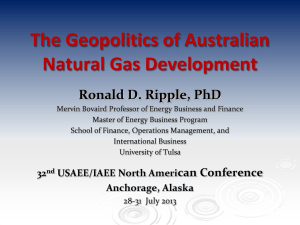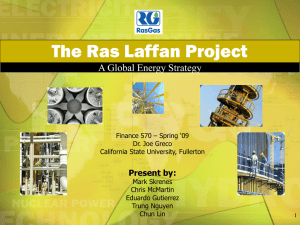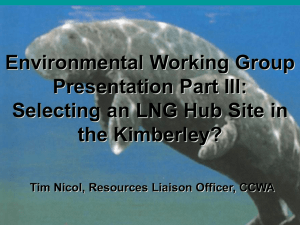スライド 1
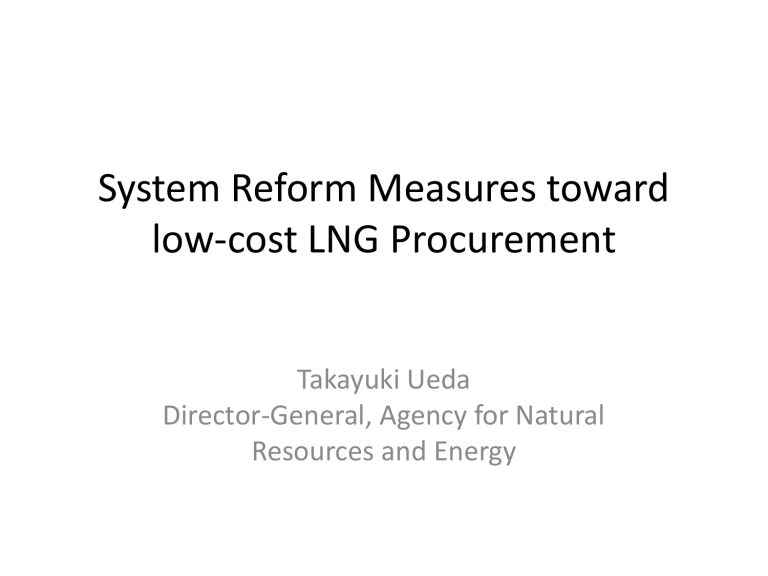
System Reform Measures toward low-cost LNG Procurement
Takayuki Ueda
Director-General, Agency for Natural
Resources and Energy
Changes in the mix of electric power generation sources by electric suppliers*
*general electric utilities and wholesale power producers
FY2010 FY2011
Ratio of coal-fired power generation
Ratio of nuclear power generation
FY2012
Ratio of LNG-fired power generation
Ratio of nuclear power generation
April 2013
Ratio of oil or other fuelfired power generation
Ratio of thermal power generation
May June
Ratio of hydroelectric generation or other power generation
1
Strategy for stable and low-cost LNG procurement
1.
Strengthening the government’s support for low-cost LNG procurement
(1) Realization of LNG import from the United States
→ Expectation for additional permission of LNG export to Japan, following export projects in Freeport and Lake
Charles
(2) Promoting competition between suppliers through the diversification of supply sources
→ Support Japanese companies participating in project developments in Russia, the United States, Canada,
Mozambique, etc., in order to diversify supply sources and promote competition between LNG sellers.
(3) Strengthening government’s support for projects that would contribute to lowering LNG import prices
→ Enhance support programs for projects which are expected to help reduce LNG import prices far below he
Japan LNG Cocktail (JLC).
(4) Strengthening of partnerships between LNG consuming countries
→ Strengthen partnerships with LNG consuming countries and regions including South Korea, India, EU, etc. and raise bargaining power over LNG supplying countries.
2. Promotion of national system reform
(1) Promotion of electricity system reform
→ Encourage efforts for the reduction of fuel procurement costs through competition between electric utilities.
(2) Implementation of strict electricity rate review
→ Carry out electricity rate review in consideration of LNG procurement prices which are determined based on cost saving efforts made in the future by electric utilities, and curb an increase in electricity rates. We continue electricity rate review in a strict manner.
3. Reinforcement of positions in negotiation through increased options for energy procurement
→ Coal-fired power generation will keep an important position as an option in negotiations with other countries for low-cost LNG procurement. We will consider to resume operations of nuclear power plants if their safety is confirmed by the Nuclear Regulation Authority and strive to diffuse energy conservation on a larger scale.
2
1. Electricity system reform
Process of law amendment
Law amendment will be undertaken in three phases, while carrying out sufficient verification for solving problems in each phase and taking necessary measures based on the results of the verification.
First amendment (legislative bill proposed and abandoned in the ordinary Diet session in 2013)
1) Establishment of wide-area transmission system operators
2) Program rules, etc.
Second amendment (in the ordinary Diet session in 2014)
1) Full liberalization of retail market
Third amendment (intends to propose legislative bill in the ordinary Diet session in
2015)
1) Legal unbundling of transmission and distribution sectors
Process of reform implementation
Decided on April 2, 2013 by the Cabinet
[Phase 1]
Around 2015
[Phase 2]
Around 2016
Establishment of wide-area transmission system operators
[Phase 3]
Around 2018-2020
To prevent power outage during a disaster by facilitating interregional wheeling services.
Full liberalization of retail sector
To allow customers to choose their power suppliers and electricity tariff.
Transitional period for phasing out regulations on electricity rates
Elimination of regulations on electricity rates
Necessary measures for customer protection
Legal unbundling
Creation of competitive market environment
3
2. Strict electricity rate assessment
When reviewing electricity rate for long-term LNG procurement, fuel cost should be calculated in the following way;
FY2013 and FY2014: the lowest price for LNG procurement among all electric utilities
FY2015: a cost-plus price that partly reflects linkage with natural gas prices (namely, Henry Hub price)
Agreed price
Non-agreed price
Current contract example A
(price: 70-80 thousand yen/ton)
“Japan LNG Cocktail (JLC)” (the average LNG imported price in Japan) Application Price
Assessed Price
Lowest price among LNG prices in existing contracts of all electric utilities, which will be renewed after the start of cost calculation period.
Assessed Price
Price which partly reflects linkage with gas-on-gas prices
(Henry Hub)
Contract linked with gas-on-gas prices
Current contract example B
(price: 30-40 thousand yen/ton)
April 2013 Cost calculation period
Expected time for realization of shale gas export from the United States to non-FTA countries
April 2015 April 2016 April 2017
4
3. Reinforcement of support for projects that would contribute to lowering LNG import prices
Expand support for providing risk money required for natural gas liquefaction projects or acquisition of shale gas interests in
North America ([investment for industrial development and trade promotion] FY2013 budget: 51 billion yen (40 billion yen),
FY2012 supplementary budget: 22 billion yen).
Also, reinforce supporting measures for LNG development projects which are expected to help reduce LNG import prices for the whole of Japan substantially below Japan’s average import price.
Moreover, begin to consider the most appropriate form of joint procurement.
Establishment of support programs for projects which are expected to help reduce LNG import prices
<Reinforcement of support programs provided by Japan Oil, Gas and Metals National Corporation (JOGMEC)>
(1) Creation of loan guarantee program of “one trillion yen” preferentially for LNG import projects
JOGMEC will create a loan guarantee program of one trillion yen preferentially for projects which are designed to reduce LNG import prices.
(2) Raising of loan guarantee limit
JOGMEC will raise the current limit of loan guarantee coverage for projects which are designed to reduce LNG import prices from 50% (normal value) to 70%.
[Effect in case that a company finances about 200 billion yen required for a project through bank loan]
The company can reduce its guaranteed borrowings from about 100 billion yen to 50 billion yen, and the remaining 50 billion yen under its guarantee can be allocated to other development projects.
(3) Decrease of exposure fee percentage
Decrease exposure fee percentage for projects which are designed to reduce LNG import prices (about 0.1% reduction * reference value is 0.8%).
[Effect in case that a company finances about 200 billion yen required for a project through bank loan]
The company can improve its cash flow by about one billion yen for normal loan guarantee period (about ten years).
<Reinforcement of support programs provided by Nippon Export and Investment Insurance (NEXI)>
Risk coverage in case that a permission of LNG export to Japan is cancelled.
In case that Japanese electric power companies or gas companies join natural gas or shale gas development projects, NEXI will cover any risks associated with the projects through foreign investment insurance.
<Reinforcement of support programs provide by Japan Bank for International Cooperation (JBIC)>
Give preferential support conditions through fiscal investment and loan, foreign currency reserves, etc.
JBIC will give preferential support conditions to projects which are designed to develop shale gas in North America or acquire resources including LNG and others through fiscal investment and loan, foreign currency reserves, etc. in the JBIC’s Loan Facility Enhancing Global Business Development established in April this year.
<Consideration of new joint procurement>
Begin to consider the most appropriate form of joint procurement to enhance our price negotiation strength.
5
